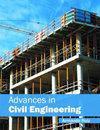Study on Nanomaterials Coated Natural Coir Fibers as Crack Arrestor in Cement Composite
IF 1.6
4区 工程技术
Q3 CONSTRUCTION & BUILDING TECHNOLOGY
引用次数: 0
Abstract
The process of inclusion of carbon nanotubes as fibers in cement paste has been proved to have optimistic effect as it enhances the tensile property of cement paste composite. Coir fibers have exceptional mechanical qualities and are thus employed as reinforcement in cement composites. Epoxy resin, which has a high Young’s modulus, is an ideal component for bonding carbon nanotubes (CNTs) to coir fiber. This paper describes a novel kind of nanocomposite made of L-12 epoxy resin and CNTs at the nanolevel, along with coir fibers at the microlevel which operate as crack arrestors. To remove surface contaminants, coir fibers are first treated with sodium hydroxide (NaOH). Epoxy/CNTs polymer coatings were developed at varying CNTs fractions (0.05, 0.1, 0.15, and 0.2 wt.% of cement). Multiwalled CNTs were combined in distilled water, followed by epoxy resin and hardener (9 : 1 v/v) polymer in an ultrasonic sonicator for 90 min to ensure full dispersion of CNTs within the epoxy polymer. This blend is now coated on the treated clustered coir fiber (length 10 cm, 10 strands) and reinforced along the length of a cement composite beam 20 mm × 20 mm × 80 mm in size. Tensile and three-point tests were performed to evaluate the mechanical characteristics of the hybrid composite. The linear elastic finite element analysis is employed to distinguish their failure phenomena via fatigue or fracture behavior. The microstructure behavior and the effect of coating material on the coir fibers were investigated using scanning electron microscope and EDX analysis. The reinforcing impact of nanopolymer coated coir fiber in cement composite diminished the tensile and flexural strength after 0.1 wt.% of CNT fraction but increased the composite’s durability and Young’s modulus. Fourier transform infrared spectroscopy analysis was carried out to assess the chemical interaction between the epoxy/CNTs and the coir fibers. The simulation was performed using ANSYS workbench, and the modeling results were within an acceptable 10% range of the experimental data. Nevertheless, it can be concluded that the hybrid composite is capable of enhancing the composite’s stress and strain capacity by regulating the fracture propagation process at the crack’s end.纳米材料涂层天然椰壳纤维作为水泥复合材料防裂剂的研究
事实证明,在水泥浆中加入碳纳米管作为纤维的工艺效果很好,因为它能增强水泥浆复合材料的拉伸性能。椰壳纤维具有优异的机械性能,因此被用作水泥复合材料的增强材料。环氧树脂具有很高的杨氏模量,是将碳纳米管(CNT)粘合到椰壳纤维上的理想成分。本文介绍了一种新型纳米复合材料,它在纳米级由 L-12 环氧树脂和碳纳米管制成,在微米级由可用作裂纹抑制器的棕纤维制成。为了去除表面污染物,首先用氢氧化钠(NaOH)处理棕纤维。环氧树脂/碳纳米管聚合物涂层的开发采用了不同的碳纳米管比例(水泥重量百分比分别为 0.05、0.1、0.15 和 0.2)。多壁碳纳米管在蒸馏水中混合,然后与环氧树脂和固化剂(9:1 v/v)聚合物在超声波发生器中混合 90 分钟,以确保碳纳米管完全分散在环氧聚合物中。现在,这种混合物被涂覆在经过处理的簇状棕纤维(长 10 厘米,10 股)上,并沿着水泥复合梁的长度方向进行加固,复合梁的尺寸为 20 毫米 × 20 毫米 × 80 毫米。为评估混合复合材料的机械特性,进行了拉伸和三点试验。采用线性弹性有限元分析来区分其疲劳或断裂行为的失效现象。使用扫描电子显微镜和 EDX 分析方法研究了棕纤维的微观结构行为和涂层材料的影响。在水泥复合材料中涂覆纳米聚合物的棕纤维的增强作用降低了 0.1 wt.% CNT 分数后的拉伸和弯曲强度,但提高了复合材料的耐久性和杨氏模量。傅立叶变换红外光谱分析评估了环氧树脂/CNT 与椰壳纤维之间的化学作用。模拟使用 ANSYS workbench 进行,建模结果与实验数据相差 10%,在可接受的范围内。不过,可以得出结论,混合复合材料能够通过调节裂纹末端的断裂扩展过程来提高复合材料的应力和应变能力。
本文章由计算机程序翻译,如有差异,请以英文原文为准。
求助全文
约1分钟内获得全文
求助全文
来源期刊

Advances in Civil Engineering
Engineering-Civil and Structural Engineering
CiteScore
4.00
自引率
5.60%
发文量
612
审稿时长
15 weeks
期刊介绍:
Advances in Civil Engineering publishes papers in all areas of civil engineering. The journal welcomes submissions across a range of disciplines, and publishes both theoretical and practical studies. Contributions from academia and from industry are equally encouraged.
Subject areas include (but are by no means limited to):
-Structural mechanics and engineering-
Structural design and construction management-
Structural analysis and computational mechanics-
Construction technology and implementation-
Construction materials design and engineering-
Highway and transport engineering-
Bridge and tunnel engineering-
Municipal and urban engineering-
Coastal, harbour and offshore engineering--
Geotechnical and earthquake engineering
Engineering for water, waste, energy, and environmental applications-
Hydraulic engineering and fluid mechanics-
Surveying, monitoring, and control systems in construction-
Health and safety in a civil engineering setting.
Advances in Civil Engineering also publishes focused review articles that examine the state of the art, identify emerging trends, and suggest future directions for developing fields.
 求助内容:
求助内容: 应助结果提醒方式:
应助结果提醒方式:


